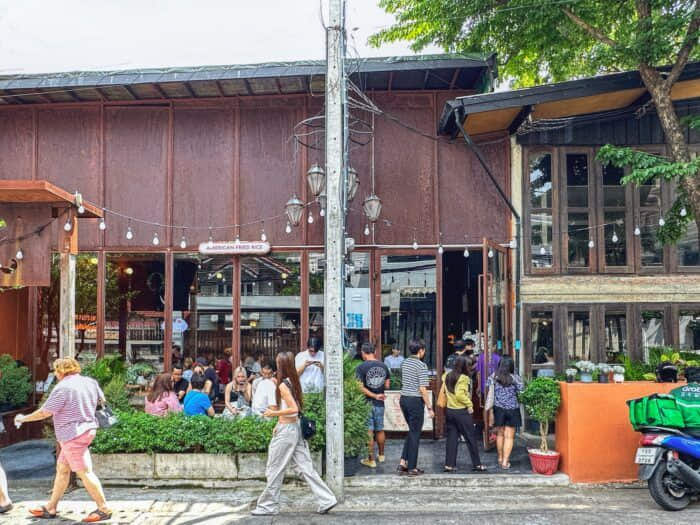We often say good food is “worth the wait” but GrabFood’s most in-demand dining establishments don’t take chances on waiting time.
Merchants who sell food through the Grab app work hard to improve preparation and delivery times, using their own systems alongside Grab’s to make sure food is delivered hot and in record time.
One such merchant, Lucky’s Hungry, serves up American fried rice at their restaurant at Bangkok foodie hotspot Soi Ari and to local homes via the GrabFood app. This fusion dish combines Thai fried rice with “American” ingredients, like sausage and bacon.

Customers love the consistently prompt delivery of Lucky’s Hungry’s inventive rice combos: the restaurant maintains a five-star rating on GrabFood, and recently won an operational excellence award at Thailand’s #GrabThumbsUp Awards 2024.
The award recognises merchants who achieve high sales volume while demonstrating efficiency in their operation and management system, including food order management, food preparation, and quick delivery times to delivery partners.
What’s the secret sauce in Lucky’s Hungry’s five-star rating and accolades?
The order management system (and team) in action
Lucky’s Hungry started as a delivery business, only later opening a storefront in Soi Ari. Maintaining high delivery service standards is in the business’ DNA—it’s something Lucky’s Hungry co-founder Natthanon Sittipanyapat takes pride in.
“It’s always a question of how to get food into the hands of customers with the highest quality,” Natthanon explains. This is why Natthanon and fellow co-founder Yutdanai Pimsopha put a well-oiled management system at the heart of their operations.

Incoming online food orders are immediately dispatched to the kitchen via the point-of-sales (POS) system which is handled by staff at the cashier. Once it is placed, a “kitchen operating system helps streamline the cooking of each order,” says Natthanon. On top of that, Lucky’s Hungry implemented human quality checks along the way: each order is reviewed before the cooking begins and confirmed by an inspector after the food is finished.
A significant share of Lucky’s Hungry’s orders come through Grab. This helps the process, “as orders placed through the Grab Food system are quite clear, and few errors are made,” Natthanon says.
Packaging, technology and feedback keeps them on track
To ensure swift delivery and to minimise waiting time for delivery-partners, a restaurant like Lucky’s Hungry must have a good understanding of how long it takes to prepare each dish.
Following “just in time” principles, a delivery-partner will be sent to the pick-up location only when Lucky’s Hungry sends out a confirmation that the order is nearly ready. If some wait time can’t be avoided, Lucky’s Hungry provides a waiting area for delivery drivers inside the store.
Lucky’s Hungry team “pays close attention to feedback, whether positive or negative,” explains Natthanon. “This is evident through star ratings and daily sales numbers.” Grab’s system provides the restaurant useful statistical information every day.
For instance, “We will look at the areas with the highest orders; paying power per bill; average age; gender; etc.” This data helps the team understand consumer demand and anticipate trends,” says Natthanon.
Finally, feedback received through the Grab app also helps shape Lucky’s Hungry products: “It allows us to constantly improve to create the greatest possible impression,” Natthanon explains. “For example, we learned that not all customers like having raisins in their rice.” The restaurant now makes them optional, available for an extra THB 5 per order.
Even the packaging wasn’t immune from tinkering, and they improved on it to find a solution that “won’t crush or leak,” Natthanon says.
(Also read: Is the customer always right? Merchants are reading reviews to get feedback)

A straightforward recipe for success
Lucky’s Hungry continues to deliver its inventive menu with unerring speed to their GrabFood customers – and don’t look to stop anytime soon. How are they able to perform at such a high level for delivery customers, consistently over time?
Natthanon believes the recipe to Lucky’s Hungry’s success is quite straightforward. “For those who own a food business on the Grab, what will make you successful is honesty; maintaining good standards; attention to customers at all times, and professionalism,” he explains.
“All of this will help us to survive and stand out in today’s fierce competition—when you have these things, our brand easily enters the hearts of customers,” he concludes. “And if you have a good platform, the more it helps us run our business smoothly.”
3 Media Close,
Singapore 138498
Komsan Chiyadis
GrabFood delivery-partner, Thailand
COVID-19 has dealt an unprecedented blow to the tourism industry, affecting the livelihoods of millions of workers. One of them was Komsan, an assistant chef in a luxury hotel based in the Srinakarin area.
As the number of tourists at the hotel plunged, he decided to sign up as a GrabFood delivery-partner to earn an alternative income. Soon after, the hotel ceased operations.
Komsan has viewed this change through an optimistic lens, calling it the perfect opportunity for him to embark on a fresh journey after his previous job. Aside from GrabFood deliveries, he now also picks up GrabExpress jobs. It can get tiring, having to shuttle between different locations, but Komsan finds it exciting. And mostly, he’s glad to get his income back on track.

